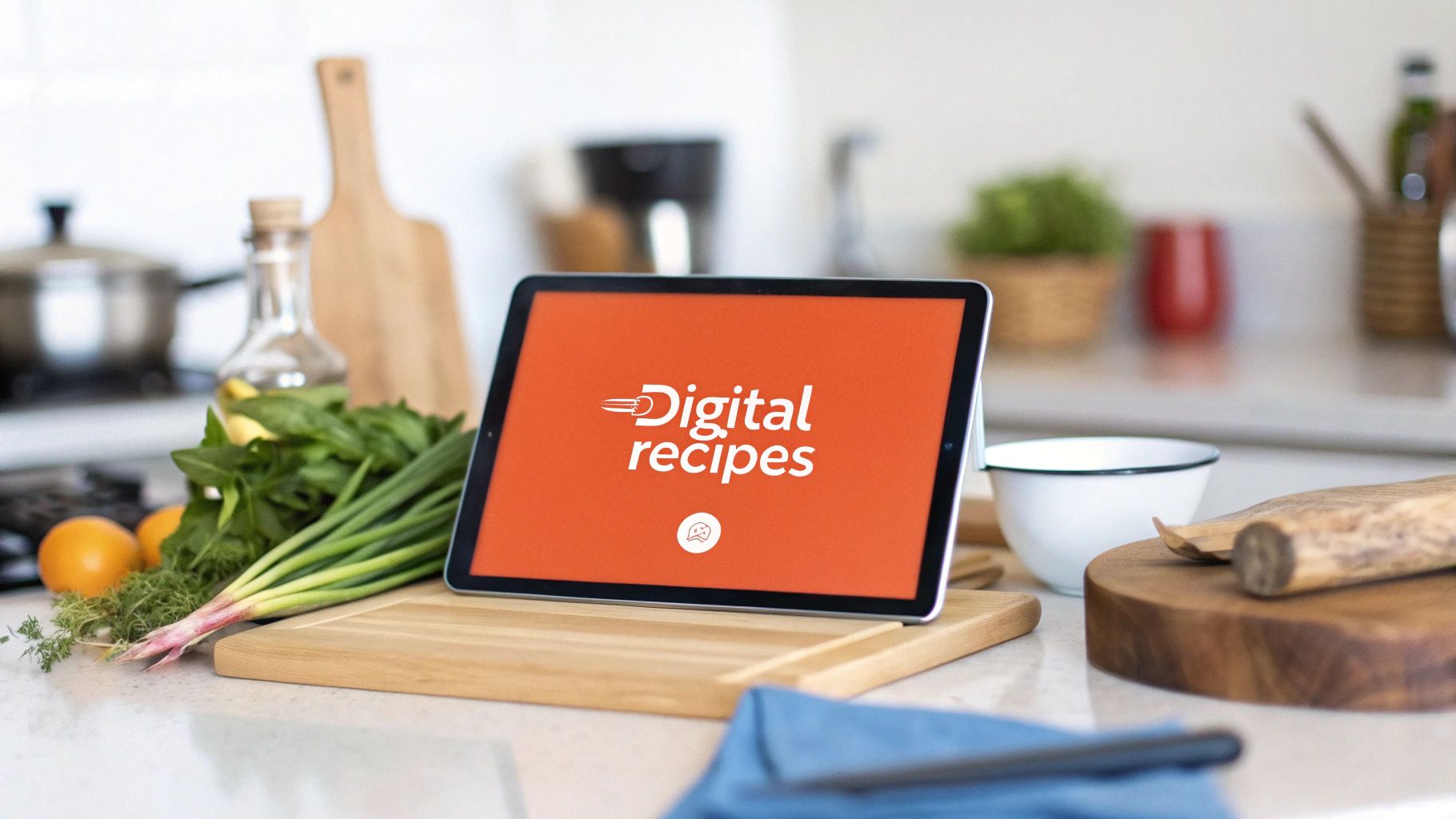Why Going Digital Transforms Your Recipe Experience
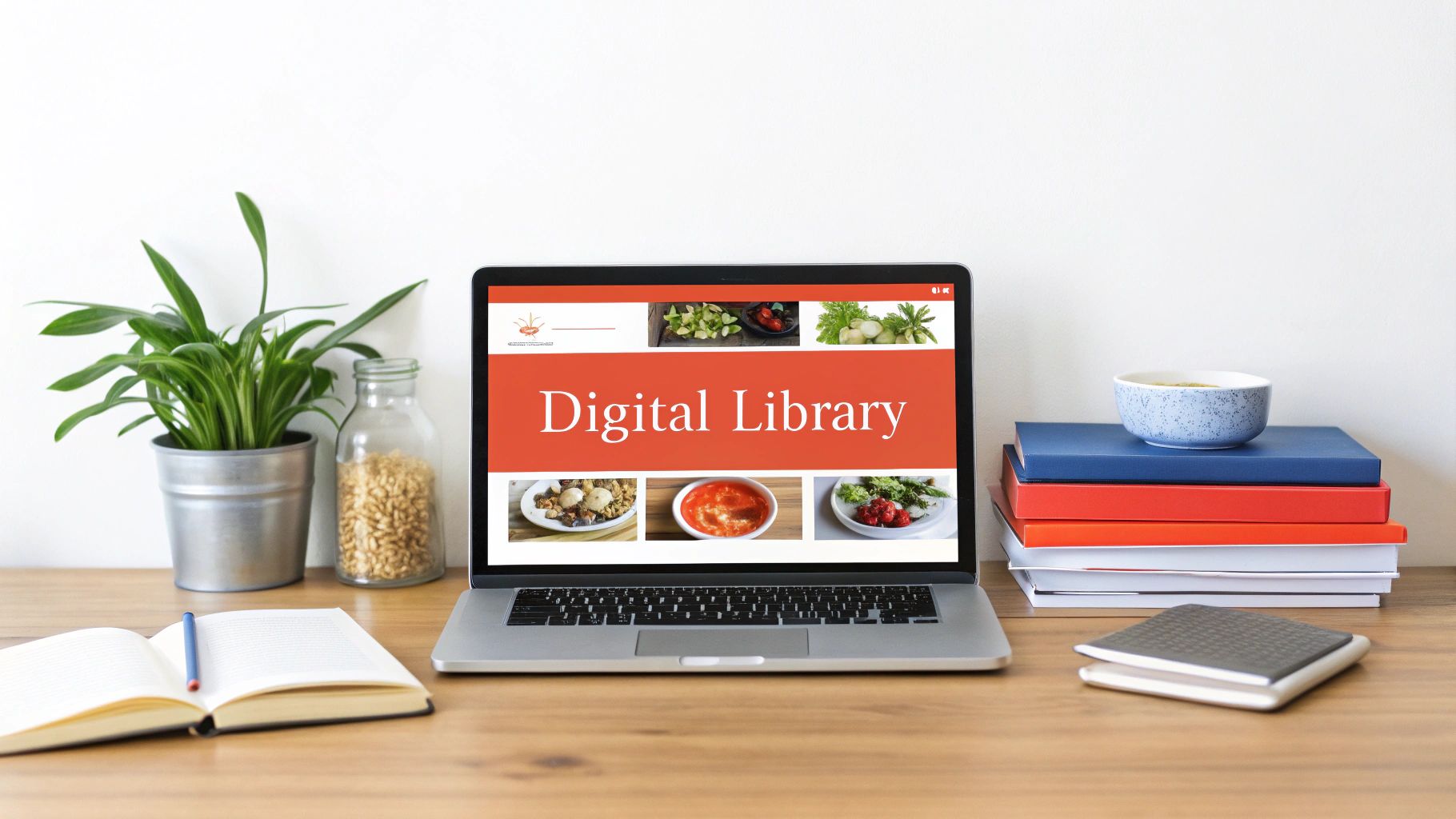
Let's be honest, that overflowing recipe box and those stained cookbooks aren't exactly inspiring culinary creativity. They're more likely to cause kitchen chaos. This is where digitizing your recipes comes in. It's more than just a modern approach; it's a total kitchen game-changer.
Imagine instantly accessing grandma's famous apple pie recipe, even if you're miles away. No more frantic phone calls or rummaging through drawers. With digital organization, your entire recipe collection is readily available at your fingertips. This also makes sharing your culinary treasures with family and friends a breeze.
Protecting Precious Family Recipes
Digitizing recipes also offers important protection for irreplaceable family heirlooms. A spilled drink or a misplaced sticky note can spell disaster for a handwritten recipe card. A digital copy, however, ensures these culinary traditions are preserved for future generations.
This easy access changes how you plan meals. Searching for dinner inspiration becomes a quick search, not a frustrating paper chase. It simplifies the entire cooking process. The increasing popularity of digital recipe organization reflects a broader shift in how people interact with food. The Digital Recipe Consumption Market, valued at USD 625.91 million in 2024, is projected to reach USD 1,706.30 million by 2031, growing at a CAGR of 15.40%. This growth is driven by increased smartphone usage, improved internet access, and the influence of food-focused social media. Explore this topic further.
Addressing the Emotional Attachment to Physical Recipes
Many cooks have a strong emotional connection to their physical recipe collections. This is completely understandable. These recipes often hold precious memories and sentimental value. Digitizing your recipes doesn't mean discarding your cherished cookbooks or handwritten cards.
Instead, think of it as creating a backup, while also making your recipes more practical for everyday use. You can keep the physical copies for sentimental reasons while enjoying the convenience of digital access.
Practical Strategies for Preserving Sentiment
There are many ways to preserve the sentimental value of physical recipes while embracing digital organization. Consider taking high-quality photos of your handwritten cards and adding them to your digital collection. This allows you to retain the personal touch while protecting the originals from further kitchen wear and tear. Ultimately, learning how to organize recipes digitally empowers you to make the most of your culinary collection, fostering creativity and connection in the kitchen.
Finding Your Perfect Recipe Management Platform
Choosing the right platform for organizing your recipes digitally can feel like a daunting task. With so many options available, each claiming to be the ultimate solution, making the wrong choice can quickly lead to frustration and negate the effort you put into digitizing your recipes.
So, how do you navigate the numerous options and select a platform that truly meets your needs?
Key Features to Consider
Focus on essential features rather than unnecessary extras. A user-friendly interface is paramount. You want a platform that's intuitive and enjoyable, not one that adds to your stress. Consider these key features:
- Import Capabilities: Seamlessly import recipes from websites and other sources.
- Organization Tools: Look for robust tagging, categories, and search functionality.
- Cross-Platform Compatibility: Access your recipes on your phone, tablet, or computer.
- Sharing Options: Easily share recipes with friends and family.
- Offline Access: View your recipes even without an internet connection.
To illustrate the variety available, let's look at a comparison of some popular recipe management apps:
To help you compare your options, the table below summarizes the key features and pricing of some popular recipe management apps.
Popular Recipe Management Apps Comparison: A detailed comparison of the top recipe organization apps based on key features, pricing, and user experience.
| App Name | Price | Device Compatibility | Key Features | User Rating |
|---|---|---|---|---|
| Paprika | One-time purchase (around $5-$30 depending on the device) | iOS, Android, macOS, Windows | Recipe import, meal planning, grocery lists, pantry tracking | Generally high (4+ stars) |
| Plan to Eat | Subscription (around $40/year) | Web-based, iOS, Android | Recipe import, meal planning, grocery lists, drag-and-drop interface | Generally positive |
| ChefTap | Free with optional premium features | Web-based, iOS, Android | Recipe import, meal planning, grocery lists, recipe clipping extension | Mostly positive reviews |
| AnyList | Free with optional premium features | iOS, Android, macOS, Web | Grocery lists, recipe management, meal planning, sharing features | High ratings (4+ stars) |
| BigOven | Free with optional premium features | iOS, Android, Web | Recipe import, meal planning, grocery lists, large recipe database | Mixed reviews |
This table offers a quick glimpse at several popular options. Remember to delve deeper into each app to find the best fit for your individual needs. User reviews can offer valuable insights.
Free vs. Premium: Is it Worth the Investment?
Many free recipe management apps provide basic functionality, but often come with limitations such as ads or limited storage. Some free apps restrict the number of recipes you can save or limit access to certain features. This can hinder your organizational efforts in the long run. Premium platforms often provide valuable features worth the investment, like advanced search filters, meal planning tools, and automatic grocery list generation. For more tips on organizing your digital recipes, check out this helpful resource: How to master your digital recipe collection.
Real User Experiences: What Matters Most
Learning from other users' experiences can be invaluable in your search. Many home cooks have shared their challenges and successes with digital recipe management. Common pain points include difficulty importing recipes from websites, managing handwritten recipe cards, and organizing photos. Finding the right platform is crucial for success with digital document management. Resources like this one on document management best practices can provide helpful guidance.
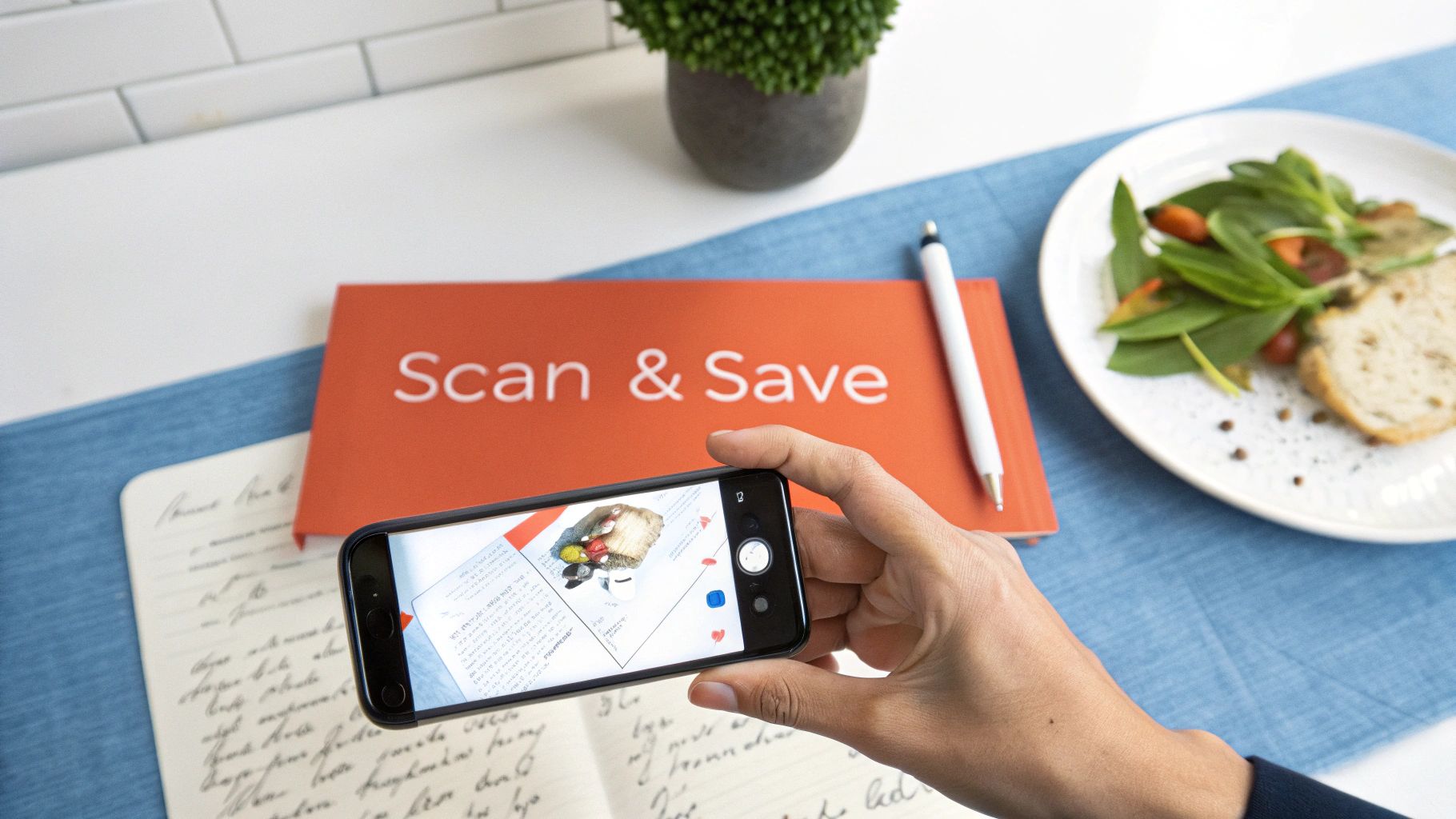
The growing recipe app market, projected to reach USD 2,268 million by 2033 with a CAGR of 13.5% from 2023, underscores the increasing popularity of home cooking and advancements in smart kitchen technology. Find more detailed statistics here.
Finding the right digital recipe management platform can truly enhance your cooking experience. By focusing on essential features, considering the pros and cons of free and premium options, and learning from other users, you can create a digital recipe collection that is both practical and enjoyable.
Creating a Recipe Organization System That Actually Works
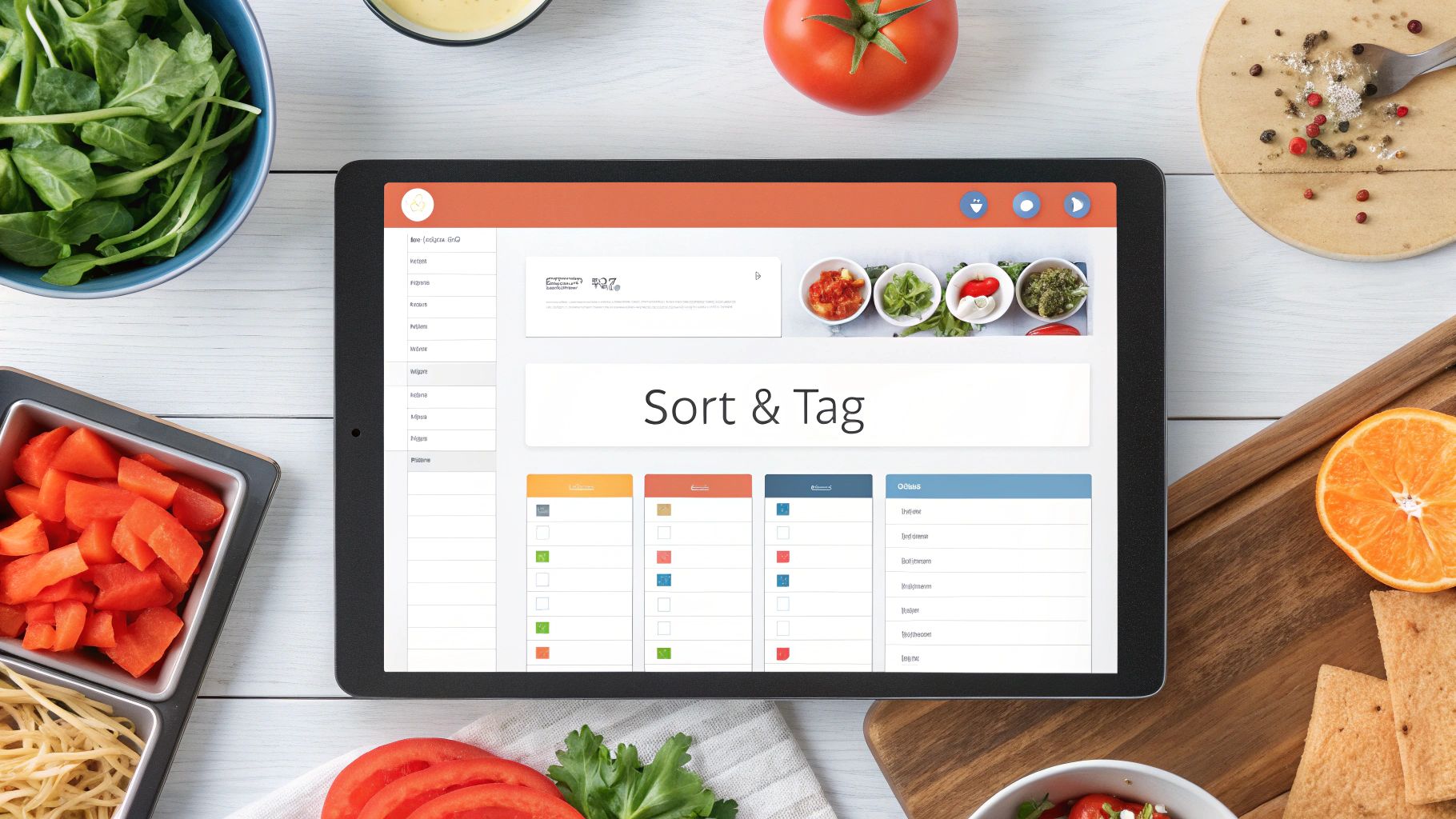
The key to a successful digital recipe collection isn't just having the recipes. It's having a system that makes them easy to find and use. A well-organized system transforms your collection into a valuable daily tool, not a digital graveyard of forgotten dishes. So, how do you build a system that actually works?
Moving Beyond Basic Categories
Basic categories like "desserts" or "main courses" are a good starting point. But truly effective organization goes deeper. Think about how you think about food. Do you cook based on seasonality, cuisine type, or even your mood?
Consider creating categories like "Comfort Food," "Quick Weeknight Meals," or "Summer Grilling." This personalized approach makes finding the perfect recipe much more intuitive. You might be interested in: How to master your digital recipe organization.
The Power of Tagging
Tagging is a powerful tool for organized cooks. It allows a single recipe to exist in multiple categories at the same time. For example, a recipe for grilled chicken salad could be tagged with "chicken," "salad," "summer," "grilling," and "healthy."
This multi-faceted approach lets you find it no matter how you're searching. Also, try to use consistent tagging conventions. This will help you avoid creating duplicate tags like "grill" and "grilling."
Implementing Your System
Putting this into practice means choosing a platform that supports robust organization. Exploring options with features like categories, folders, and tags is useful when choosing a recipe management platform, and you may find value investigating the best document management systems. Experiment with different platforms to find what works best for your needs.
Here's a step-by-step guide for implementing a personalized system:
- Identify Your Cooking Style: How do you typically choose recipes? What factors influence your decisions?
- Create Main Categories: Start with broad categories that reflect your overall cooking habits.
- Develop Subcategories and Tags: Break down your main categories into more specific groupings and add relevant tags.
- Regularly Review and Refine: Your system should evolve as your cooking style and recipe collection change and grow.
Examples of Effective Organization
Visual examples can be incredibly helpful. A screenshot of a well-organized recipe collection, demonstrating effective use of categories and tags, can offer great inspiration.
Many online communities dedicated to digital recipe organization share examples and offer helpful tips. This collaborative environment allows you to learn from others and continually refine your own system, ensuring your collection stays a valuable resource.
Transforming Paper Recipes Into Digital Treasures
That stack of recipe cards and dog-eared cookbooks holds years of culinary memories. However, managing these physical copies can become a real headache. Digitizing your recipes makes them easier to access and search. Thankfully, it's simpler than you might think to transform your treasured recipes into a digital format. You might be interested in this helpful guide: How to organize your printed recipes.
Comparing Digitization Methods: From Snapshots to OCR
There are several ways to digitize your recipes, each with its own pros and cons. Taking smartphone photos is the simplest method. It's quick and easy, but image quality can be inconsistent, especially if the lighting isn't ideal. Plus, the text within the photo isn't searchable.
Scanning apps offer a more sophisticated approach. Many use Optical Character Recognition (OCR) to convert images of text into searchable digital text. This is especially helpful for typed recipes, making finding them a breeze. However, OCR can sometimes struggle with handwritten recipes.
Preserving Handwritten Notes and Challenging Lighting Conditions
Handwritten recipes, or those with notes scribbled in the margins, require special attention. Consider dedicated scanner apps with features for capturing fine details. Look for apps that let you adjust the brightness and contrast to ensure your digital copy preserves every detail.
For the highest quality, a document scanner is the best option. While requiring a separate piece of equipment, it provides the best results for delicate or faded documents. Many document scanners also offer OCR capabilities.
Batch Processing and Outsourcing: Strategies for Efficiency
If you have a large collection of recipes, batch processing can help you stay organized. Group your recipes before you start digitizing. This could be by category (desserts, main courses, etc.), source (specific cookbooks), or whatever system works best for you.
Outsourcing is a worthwhile investment for extensive collections. Services specializing in digitizing documents can free up your time. They'll also ensure a consistent, high-quality result. This is particularly helpful if you're short on time or uncomfortable handling fragile documents. It lets you focus on cooking while professionals handle the technical details.
Preserving Cherished Family Recipes for Generations to Come
Digitizing recipes protects them from wear and tear. Creating digital backups ensures these culinary traditions are preserved for years to come. This goes beyond just the practical aspects, allowing you to share these recipes easily with family and friends.
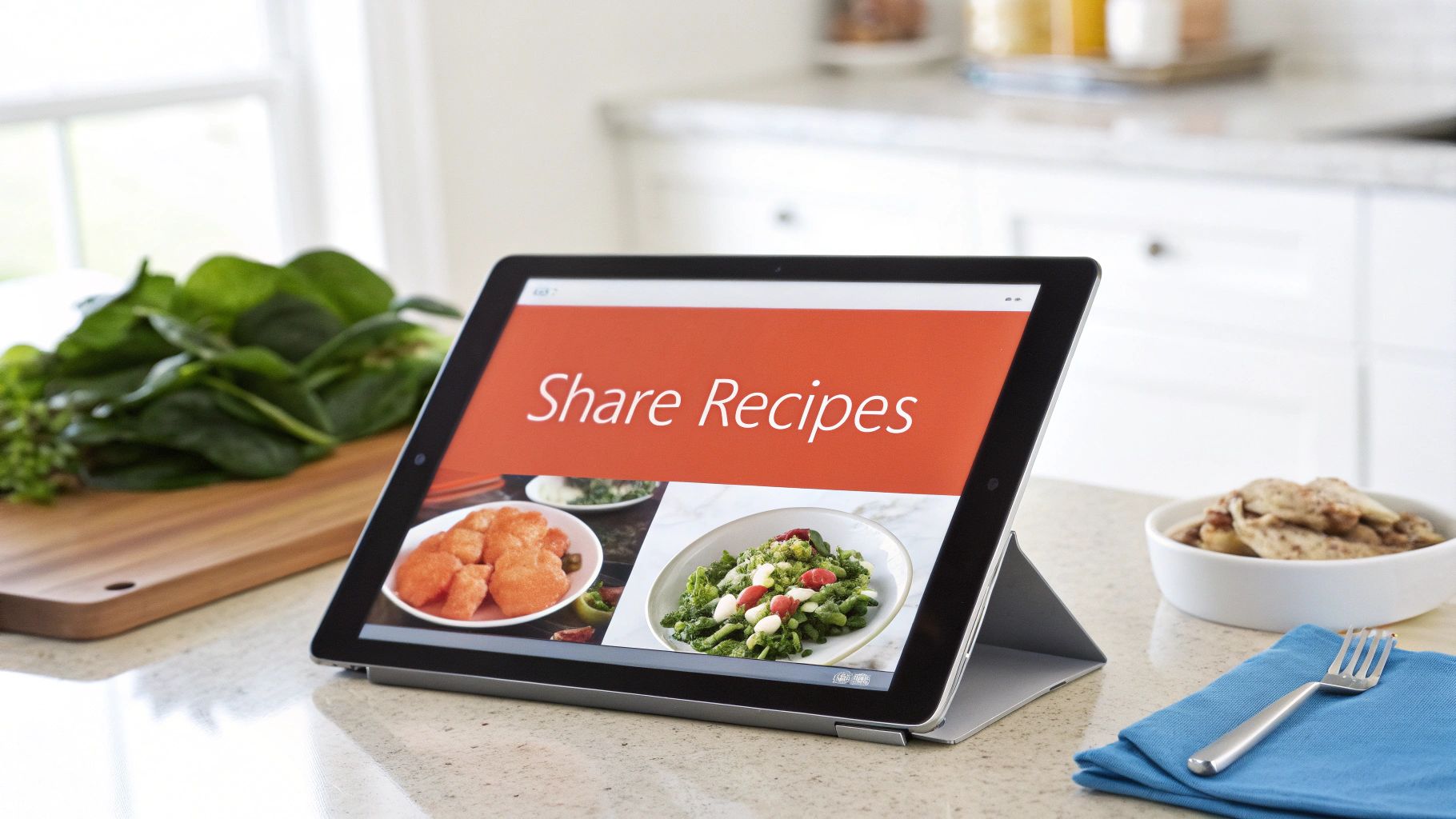
Beyond personal use, Recipe Management Systems play a significant role in the food industry. The global market, valued at USD 1624.5 million in 2024, is projected to grow at a CAGR of 8.0% to 11.8%. This highlights the growing need for efficiency and consistency in food preparation, both at home and professionally. Read the full research here. Digitizing captures not just the ingredients and instructions, but also the stories and memories behind each dish.
Unlocking Advanced Features That Transform Everyday Cooking
Organizing your recipes digitally offers more than just simple searchability. It's about using features that streamline your entire cooking process, from planning meals to sharing your culinary masterpieces. Let's explore how these advanced features can improve your time in the kitchen.
Streamlining Meal Planning and Grocery Shopping
Imagine planning your meals for the week in minutes. Many digital recipe platforms offer meal planning integration, allowing you to drag and drop recipes into a weekly calendar. This eliminates the stress of deciding what to cook each night. Automatic shopping list generation takes this efficiency a step further. The app compiles a list of all the ingredients you need, organized by grocery store aisle. This helps avoid forgotten ingredients and reduces impulse buys, saving you time and money.
Nutritional Calculations and Portion Scaling: Health-Conscious Cooking Made Easy
For the health-conscious cook, nutritional calculation features offer detailed information about each recipe. You can see calories, macros, and micronutrients at a glance. This data allows you to make informed choices about your diet and adjust recipes to meet your health goals. Portion scaling is another helpful tool, especially when cooking for a group or adjusting recipes for leftovers. You simply enter the desired number of servings, and the app automatically adjusts the ingredient quantities. This eliminates mental math and reduces food waste.
To understand the benefits these features offer, let's look at a detailed table:
Advanced Digital Recipe Features and Their Benefits
Overview of sophisticated recipe management features and their practical applications for home cooks
| Feature | Description | Practical Benefit | Platforms Offering This |
|---|---|---|---|
| Meal Planning Integration | Drag and drop recipes into a weekly calendar | Streamlines meal planning, saves time | Paprika, Mealime |
| Automatic Shopping List Generation | Creates a grocery list based on planned meals | Eliminates forgotten ingredients, reduces food waste | Paprika, Mealime, AnyList |
| Nutritional Calculation | Provides detailed nutritional information for each recipe | Supports healthy eating choices, adapts recipes to dietary needs | Paprika, MyFitnessPal |
| Portion Scaling | Adjusts ingredient quantities based on desired servings | Simplifies cooking for crowds, reduces mental math | Most recipe apps and websites |
| Smart Device Integration | Connects recipes to cooking equipment | Streamlines cooking process, allows for remote control | Yummly, Drop Recipes |
| Cloud Synchronization | Access recipes across multiple devices | Ensures recipes are always available, no matter where you are | Almost all modern recipe platforms |
This table summarizes how digital recipe features can enhance your cooking experience, offering various functionalities from meal planning to smart device integration. Many platforms like Paprika, Mealime, and Yummly incorporate several of these time-saving features.
Smart Device Integration and Cloud Synchronization: Cooking in the Connected Age
Smart device integration connects your digital recipes to your kitchen appliances. Some platforms can even preheat your oven or start your slow cooker remotely. This level of connectivity integrates your digital recipe collection into your daily kitchen workflow. Cloud synchronization ensures your recipes are accessible wherever you are. You can access your collection on your phone, tablet, or computer, so you'll never misplace a favorite recipe again.
Transforming Everyday Cooking
These advanced features, when used effectively, can shift everyday cooking from a chore to a more creative and enjoyable experience. They empower you to try new recipes, cook healthier meals, and spend less time planning and shopping, leaving you more time for the pleasures of cooking and sharing meals with loved ones.
Maintaining a Living Cookbook That Evolves With You
A truly valuable digital recipe collection isn't a fixed entity. It's a constantly growing record of your culinary journey, adapting to your changing tastes and expanding skillset. This means more than simply adding new recipes; it requires active maintenance and updates.
The Importance of Post-Cooking Notes
Post-cooking notes are one of the most effective ways to improve your digital recipe collection. They go beyond the original instructions, capturing the details of your actual cooking experience. Did you tweak the seasoning? Swap out an ingredient? These specifics are key to replicating a dish and avoiding previous missteps.
For example, a note might read, "Reduced sugar by 1/4 cup and added a pinch of salt. Perfect sweetness!" These seemingly small changes can significantly impact the final product. Over time, these notes transform your recipes into personalized versions tailored to your liking.
Version Control: Tracking Your Culinary Growth
Your recipes should evolve alongside your cooking skills. Version control lets you track these adjustments, preserving both the original recipe and your modifications. While most recipe management apps lack formal version control, you can create your own system easily.
Simply add a note with the date and changes made, like "Version 2 – 10/27/2024 – Increased cooking time by 5 minutes." This allows you to revert to an earlier version if necessary, creating a documented history of your culinary progress.
Seasonal Rotation: Bringing Relevance to the Forefront
Our cravings shift with the seasons. Organizing your recipes seasonally ensures that relevant dishes are readily available. Create collections like "Summer Grilling," "Fall Comfort Foods," or "Winter Soups and Stews." Many apps offer tagging features, allowing recipes to appear in multiple categories for ultimate flexibility.
This proactive approach saves you from searching through countless recipes for seasonal inspiration. You'll find what you need quickly and easily, much like having a personal chef curate your menu based on the time of year.
Backup and Migration Strategies: Protecting Your Culinary Treasures
Protecting your recipes from data loss is vital. Regular backups, whether to a cloud service like Dropbox or an external hard drive, are crucial. Also consider migration strategies in case your current platform shuts down or a superior option arises.
Many apps offer recipe export in various formats, simplifying the transition to a new platform. Just like any prized collection, your digital recipes are worth safeguarding. These measures ensure your culinary memories remain safe and accessible for years to come.
Sharing Culinary Traditions Across Generations and Distances
Sharing recipes has always been a way to connect with loved ones. Now, digital recipe management offers even more powerful ways to preserve family culinary traditions and share them across generations and distances. It's a new way to build collaborative collections, from virtual family cookbooks to online cooking club archives.
Building Bridges Through Collaborative Collections
Think about your family's treasured recipes. Are they scattered on handwritten cards, tucked into stained cookbooks, or buried in old emails? Creating a central, digital repository for these culinary treasures not only preserves them but makes them accessible to everyone. This creates a living cookbook that can be continually updated and enriched.
Digital platforms like Recify offer powerful sharing tools. Many allow multiple users to contribute, add personal notes, and even upload photos of their finished dishes. Imagine cousins collaborating on grandma's famous lasagna recipe, each adding their own tips and variations. This fosters a sense of community and keeps treasured traditions alive.
Sharing Across Platforms and Devices
One challenge with digital sharing is ensuring compatibility across different devices. Some family members might be comfortable with technology, while others may need more support. Choosing a platform that works on a variety of operating systems (iOS, Android, and web browsers) is key for everyone to participate easily.
Providing clear, step-by-step instructions can bridge the tech gap. A simple guide with screenshots or even a short video tutorial can make the experience more accessible and enjoyable for everyone, regardless of their technical skills.
Encouraging Participation and Preserving Culinary Heritage
Not everyone is ready to embrace new technology. Some family members might be hesitant to leave behind their traditional recipe methods. Addressing these concerns with patience and understanding is important. Emphasize the benefits of digitization, such as safeguarding recipes from loss or damage.
Sharing success stories of other families who have made the switch can also be encouraging. The goal is not simply to organize recipes, but to preserve important culinary heritage. These recipes often hold deep sentimental value, representing family history and cultural identity.
Capturing these memories digitally ensures they can be passed down, enriching family gatherings for years to come. Digital sharing can have a profound impact on family connections. It allows families to connect through food, even when separated by distance. It creates opportunities for collaboration and strengthens bonds across generations. Sharing a family meal becomes more than just dinner; it's a celebration of shared heritage and a testament to the enduring power of food to bring people together.
Recify offers an easy and effective way to begin organizing and sharing your recipes digitally. Transform your scattered collection into a beautifully organized digital cookbook accessible from anywhere. Start your free trial today and discover the joy of a truly connected kitchen! Start your culinary journey with Recify!
